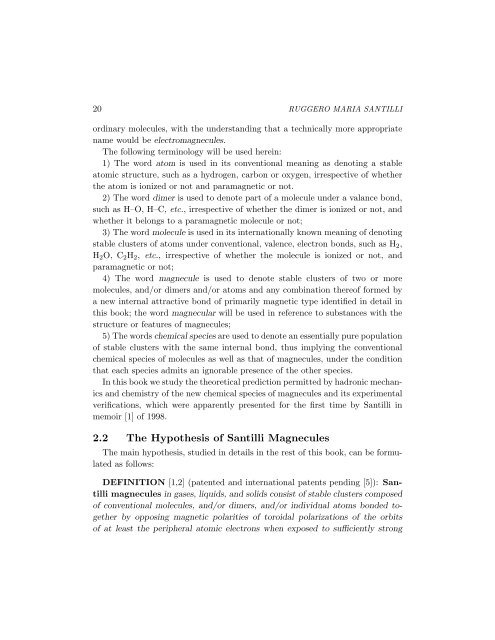the new fuels with magnecular structure - Institute for Basic Research
the new fuels with magnecular structure - Institute for Basic Research
the new fuels with magnecular structure - Institute for Basic Research
You also want an ePaper? Increase the reach of your titles
YUMPU automatically turns print PDFs into web optimized ePapers that Google loves.
20 RUGGERO MARIA SANTILLI<br />
ordinary molecules, <strong>with</strong> <strong>the</strong> understanding that a technically more appropriate<br />
name would be electromagnecules.<br />
The following terminology will be used herein:<br />
1) The word atom is used in its conventional meaning as denoting a stable<br />
atomic <strong>structure</strong>, such as a hydrogen, carbon or oxygen, irrespective of whe<strong>the</strong>r<br />
<strong>the</strong> atom is ionized or not and paramagnetic or not.<br />
2) The word dimer is used to denote part of a molecule under a valance bond,<br />
such as H–O, H–C, etc., irrespective of whe<strong>the</strong>r <strong>the</strong> dimer is ionized or not, and<br />
whe<strong>the</strong>r it belongs to a paramagnetic molecule or not;<br />
3) The word molecule is used in its internationally known meaning of denoting<br />
stable clusters of atoms under conventional, valence, electron bonds, such as H 2 ,<br />
H 2 O, C 2 H 2 , etc., irrespective of whe<strong>the</strong>r <strong>the</strong> molecule is ionized or not, and<br />
paramagnetic or not;<br />
4) The word magnecule is used to denote stable clusters of two or more<br />
molecules, and/or dimers and/or atoms and any combination <strong>the</strong>reof <strong>for</strong>med by<br />
a <strong>new</strong> internal attractive bond of primarily magnetic type identified in detail in<br />
this book; <strong>the</strong> word <strong>magnecular</strong> will be used in reference to substances <strong>with</strong> <strong>the</strong><br />
<strong>structure</strong> or features of magnecules;<br />
5) The words chemical species are used to denote an essentially pure population<br />
of stable clusters <strong>with</strong> <strong>the</strong> same internal bond, thus implying <strong>the</strong> conventional<br />
chemical species of molecules as well as that of magnecules, under <strong>the</strong> condition<br />
that each species admits an ignorable presence of <strong>the</strong> o<strong>the</strong>r species.<br />
In this book we study <strong>the</strong> <strong>the</strong>oretical prediction permitted by hadronic mechanics<br />
and chemistry of <strong>the</strong> <strong>new</strong> chemical species of magnecules and its experimental<br />
verifications, which were apparently presented <strong>for</strong> <strong>the</strong> first time by Santilli in<br />
memoir [1] of 1998.<br />
2.2 The Hypo<strong>the</strong>sis of Santilli Magnecules<br />
The main hypo<strong>the</strong>sis, studied in details in <strong>the</strong> rest of this book, can be <strong>for</strong>mulated<br />
as follows:<br />
DEFINITION [1,2] (patented and international patents pending [5]): Santilli<br />
magnecules in gases, liquids, and solids consist of stable clusters composed<br />
of conventional molecules, and/or dimers, and/or individual atoms bonded toge<strong>the</strong>r<br />
by opposing magnetic polarities of toroidal polarizations of <strong>the</strong> orbits<br />
of at least <strong>the</strong> peripheral atomic electrons when exposed to sufficiently strong














